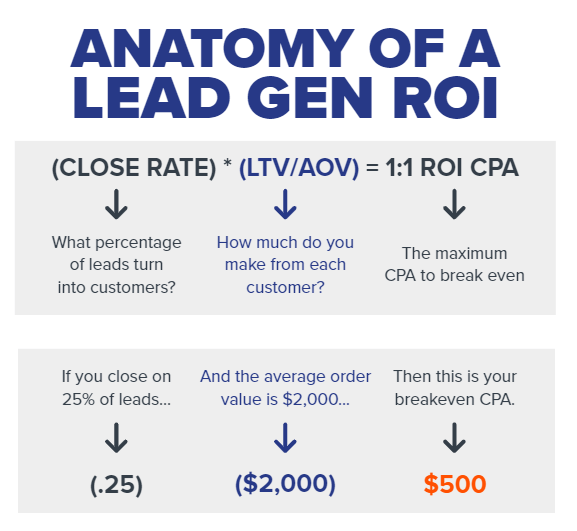There are many paid media & digital marketing agencies out there who aren’t shy about promising you the world before delivering absolutely no value.
“You said you wanted to double your leads, you didn’t say we couldn’t spend 10 times as much to do so!”
Successful paid media agencies don’t operate this way. Titan Growth was named an All-Star agency by Google (one of only a handful) because we are committed to building sustainable, scalable paid media strategies.
The truth is that paid media can offer great ROI, flexible spend, and inexpensive testing. Why, then, don’t more businesses take advantage of the opportunity to invest more in paid media?
Here are the top 5 Paid Media objections that our new business team hears on an ongoing basis:
Objection 1: Paid media is too expensive
Paid media shouldn’t be looked at as a cost. It’s an investment. If it’s working, it shouldn’t matter how much it costs.
If I gave you the following two offers, would you take the cheaper option or the more expensive one?
Offer 1 (Cheaper): You give me $10 now, and I will give you $20 tomorrow.
Offer 2 (Expensive): You give me $100.00 now, and I will give you $10,000.00 tomorrow.
Offer 2 is 1000% more expensive than offer 1, but I bet any rational person would take offer 2 all day long.
The important point isn’t how much you spend, but your return on investment (ROI). The issue is that most companies don’t have their close rates or average order value calculated, let alone customer lifetime value. You need to be looking at the numbers that actually impact ROI to understand how much money you should be spending and how much more money you’re getting by spending that money.
Of course, calculating these numbers won’t just benefit your decision on whether paid media is the right investment. It’ll also help you determine the value of all of your marketing efforts, and let you understand how to allocate those dollars.
Without knowing your target cost per acquisition (CPA) and ROI, you cannot contextualize the value that paid media brings in.

Here are some suggestions on how to get started calculating a basic ROI.
If your company closes on about 25% of leads gained, and each closed lead is worth an average of $2,000, then start your hypothetical ROI calculation at $500 CPA (Cost per acquisition). To hit a 1:1 ROI—that is, breaking even—you can’t spend more than $500 on each lead.
If you know that 50% of closed leads make another purchase, use an estimated lifetime value (LTV) for a more accurate calculation. In this case, the LTV would be ($2000) + (.5)($2000) = $3,000.
The hypothetical minimum CPA would then be (.25)($3,000) = $750.
In other words, each lead is worth, on average, an additional $250 when using a LTV calculation: thus a 1:1 ROI would be spending $750 to acquire each lead.
eCommerce is much the same, except treat ‘close rate’ as ‘conversion rate’.
If your company has a 10% purchase rate on viewing a product page, and the products average around $25 each, then start your hypothetical ROI calculation at $2.50 CPA.
Paid Media Objection 2: We can run our own automation
Automation is a useful tool, but it is far from being able to replace skilled analysts.
Here’s what automation does:
- Frees up the account manager to spend more time on big-picture strategy
- Allows the analyst team’s research and tests to show results more quickly
- Handles low-level optimizations while the team optimizes higher-level boundaries
Here’s what automation can’t do:
- Plan the strategy that underlies account performance
- Research and target the exact audience your company wants to reach
- Craft compelling ads
- Keep track of sales cycles, competitor activity, and seasonal shifts
- Day-to-day prioritization of spend allocation/budget
The truth is that the sophistication behind running a successful paid media campaign involves a team of analysts, both for daily improvements and big-picture strategy.
Automation is a great tool, given your account has a clear and curated strategy in place, but it has the potential to waste incredible amounts of money if not carefully planned and managed.
Paid Media Objection 3: We can do it in house for cheaper
Setting up an in-house paid media department might be easy, if you already have an expert account manager on payroll with enough time to do the work of an entire team, or the resources to find an experienced team that isn’t already at a top-tier agency.
Most companies would benefit from the support of a diverse team of account managers and analysts, but don’t have the resources to bring the department in-house.
Unless you have a healthy seven-figure personnel budget for your new paid media team, you won’t be able to replicate a top-tier agency’s capabilities. You also won’t be able to get dedicated support from Google and other paid media platforms with an in-house team—support that agencies are able to get even for smaller accounts.
So, yes, you can do it in-house. It might even seem like a good idea if you don’t take into account your ROI and the value of agency expertise, supplemented by a partnership with Google support. If you decide to go this route it will be important to understand the risks and rewards, and make sure the rewards far outweigh the risks.
Objection 4: Committing to one agency is too much of a risk
Choosing a marketing agency is a commitment, but it shouldn’t feel dangerous if done with care. After all, reputable agencies are comfortable sharing their approach to paid media account management, and demonstrations of their expertise—whether it’s case studies, technical blog posts, or a competitive analysis of your existing account.
Any agency that hasn’t been in business for long or is reluctant to share information as simple as case studies is a risky bet.
The challenge is to find the agency that:
- Has a track record of success.
- Shares your partnership and mutual investment goals.
- Is a top-level partner with the networks you want to advertise on.
- Has an experienced team (think A+ experienced players, not brand new analysts).
Finding the best agency for your company means finding the right partner.
We went into more detail on this point in our article Is Your Agency A Service Or A Partnership?, but here’s the quick version:
Your company and your agency partner have to be mutually invested in achieving your marketing goals.
True partnerships where both your company and your agency are committed to working together for mutual benefit aren’t risky—they’re ideal.
Objection 5: I don’t want to change the status quo
When switching agencies, there is the potential for a temporary dip in performance—but there is the certainty that new eyes will see new possibilities. Reputable agencies have developed their own techniques to avoid significant performance hits, while finding the best ways to capitalize on what your company already has.
Don’t let your company be trapped. If the relationship isn’t working for you, inertia can keep you “held hostage”, but you owe it to yourself and your company to find the right marketing partner instead of settling for paying for a service relationship.
Bottom Line:
Hiring a paid media agency is an investment worth making. Don’t hire an agency to make quick fixes, but to be your partner who builds a promotion strategy that directly contributes to your bottom line.


